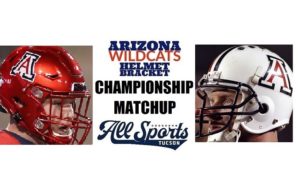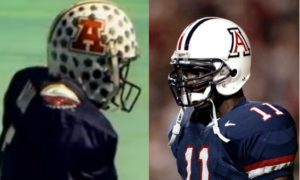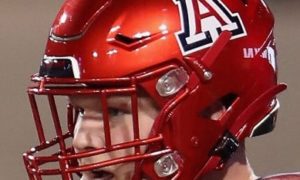THE BRACKET

CHAMPIONSHIP VOTING
The helmet Arizona wore during its best stretch in history — the 1990’s — under late coach Dick Tomey is the fans’ choice for the program’s best as determined by voting in the Arizona Wildcats Football Helmet Bracket. The Wildcats featured two of its best teams with the helmet — the 1993 team with the Desert Swarm defense that went 10-2 and beat Miami in the Fiesta Bowl and the 1998 team that finished 12-1 with a victory over Nebraska in the Holiday Bowl. Arizona was 87-76-1 wearing this helmet from 1990 to 2003.
ONE HUNDRED YEARS OF ARIZONA HELMETS
1920

Pop McKale’s Wildcats wore leather helmets 100 years ago. Arizona compiled a 6–1 record in 1920 and outscored their opponents, 381 to 65. The team captain was quarterback Alter Louis Slonaker. The IT Support Center at Arizona is now located in the Slonaker House on campus. Arizona wore brown leather helmets throughout the decade.
————
1930-39
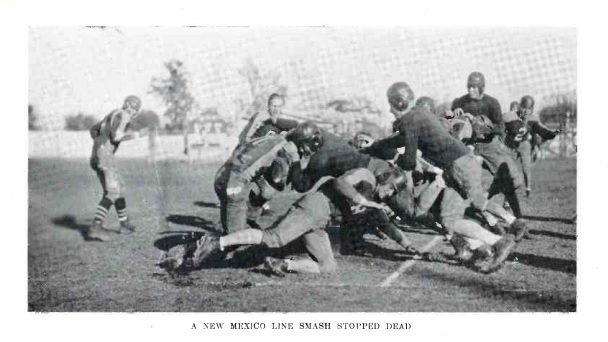
Arizona (wearing the dark navy jerseys in the photo) continued to wear brown leather helmets into the 1930s. McKale’s last season as Arizona’s coach was in 1930. His 16 years as the football coach ended with a 6-1-1 season. Arizona shut out six of eight opponents, and outscored all opponents, 122-33. The team captains were Waldo M. Dicus and William Hargis. McKale was 80-32-6 as Arizona’s football coach.
————

Arizona switched from brown leather helmets to shiny golden hardened leather with a navy blue winged design similar to Michigan in 1939. This was the first season with Miles Casteel as head coach and he implemented the “Notre Dame offense” with a three-back alignment behind the quarterback. Casteel, a Michigan native, was an assistant coach at Michigan State for 14 years before moving to Tucson.
————
1940-1949
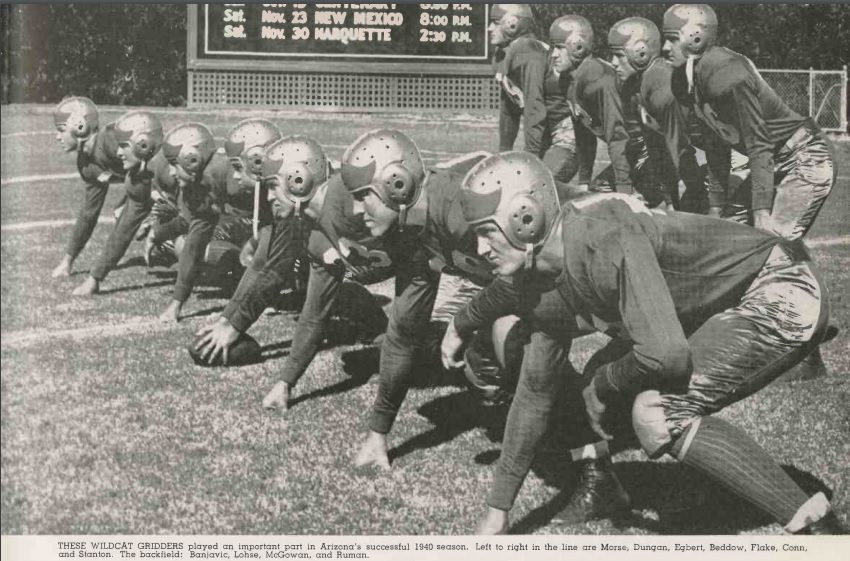

The above photo resolution is off making it look like the winged design was red and not navy blue on the golden helmet. Other photos from the 1940 season (like above against Marquette) show a dark blue design on the helmet. The Wildcats also wore gold pants and alternated with red and blue jerseys. The Wildcats went 7-2 in 1940 under Casteel with running back/defensive back John Black as the captain.
————
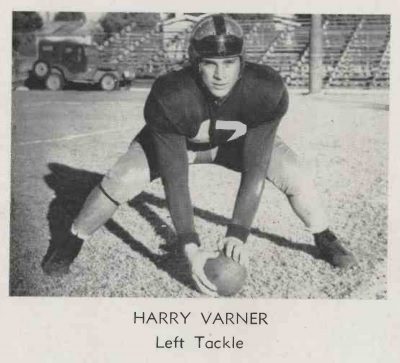
The 1946 Arizona helmet (above) still a goldened hard leather with a navy blue winged look and a red “A” at the front. The helmet was still gold and the pants were gold as well.
————

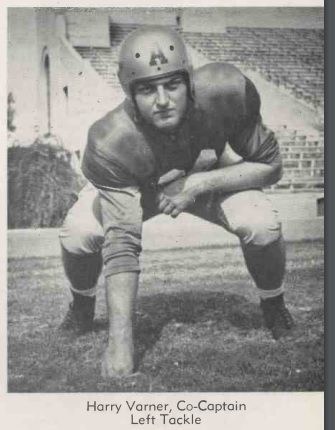
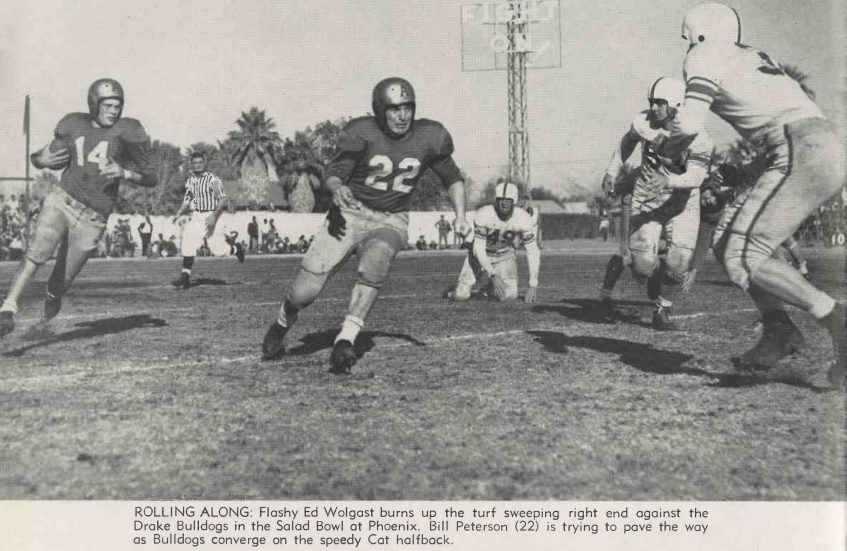
In 1948, Casteel’s last with Arizona, the Wildcats’ helmet changed to a hard plastic and remained a shiny gold with gold pants still worn. The winged look was gone and a red “A” remained on the front of the helmet. Tackle Harry Varner getting in a lot of the photos because of his popularity. The last photo shows halfback Ed Wolgast sweeping right with Bill Peterson (22) blocking for him in the 1948 Salad Bowl in Phoenix. Notice the “A” on the front of their gold helmets.
————
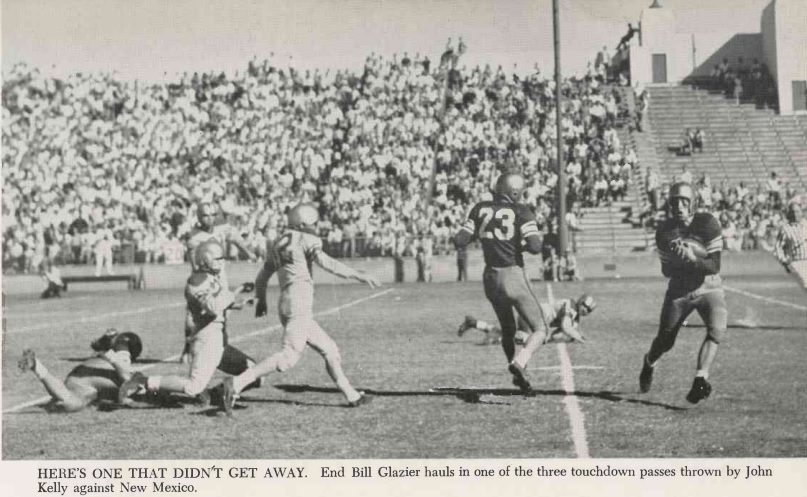
Arizona in 1949, under new coach Bob Winslow, the Wildcats continue to wear the gold helmet since 1939 but put it away for one season.
————
1950-59

In 1950, in Winslow’s second season, the Wildcats switch from the gold helmet with the red “A” in front to the dark blue helmets. The captain of this team 70 years ago was Wolgast, who the previous year in Arizona’s 14-13 loss to Drake in the Salad Bowl, finished with 133 yards rushing, eight yards more than Drake’s team total. Legendary brothers Wil and Gil Gonzales were also part of the team.
————
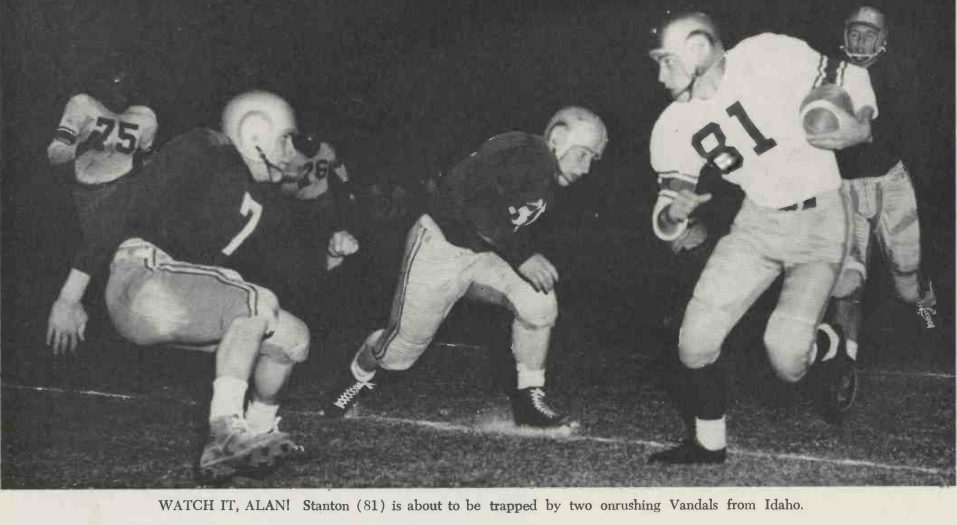
The Wildcats returned to the gold helmet in 1951 in Winslow’s last season — remember, Notre Dame had a great influence on college football programs back then from the look to some of the formations the Irish ran. Pictured is tight end Alan Stanton (81) trying to avoid two Idaho defenders. Stanton, who passed away in March, later was a coach with Arizona’s basketball program.
————

The Wildcats returned to the navy blue helmets in 1952 in Warren Woodson’s first year as head coach. Arizona’s great fullback Don Beasley (45) plows through the line in this photo. The Wildcats finished 6-4 that season.
————

The “Cactus Comet” Art Luppino (22) sports the navy blue helmet here in 1954, when he led the NCAA in rushing yardage with 1,359 rushing yards in 1954. He also led the NCAA with 1,313 rushing yards in 1954. In 1954, he also broke the NCAA modern-era single-season scoring record with 166 points. In his third year as coach, Woodson coached the Wildcats to a 7-3 record in 1954.
————
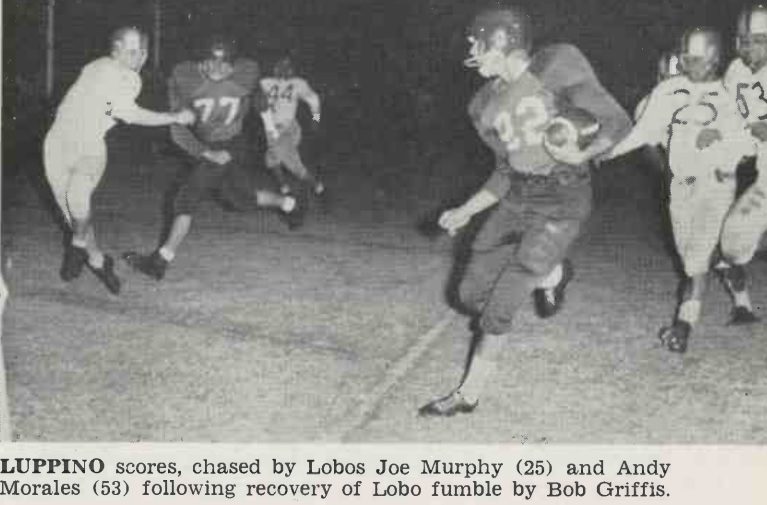
The facemask makes its debut on Arizona’s helmets in 1955. Luppino is shown in this photo with the one-bar look on his helmet.
————
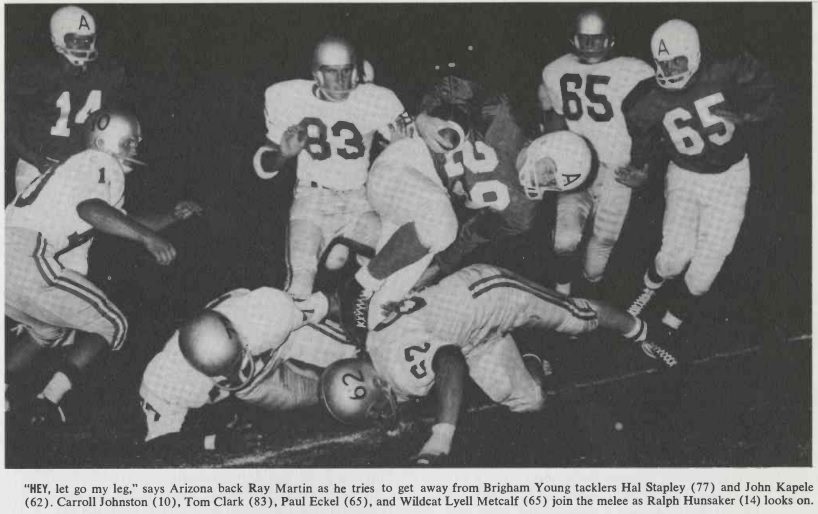
Ed Doherty’s first season as head coach in 1957 with the Wildcats brought a switch to white helmets for the first time in program history. A red “A” was placed in the front of the helmet. In this photo, Ray Martin (29) plunges over the BYU line with Lyell Metcalf (65) and Ralph Hunsaker (14) looking on. Abe Chanin of The Arizona Daily Star wrote that Doherty wanted to return to the school’s colors of navy blue, cardinal red and white, and away from the gold helmets and brown pants mixed in before.
————
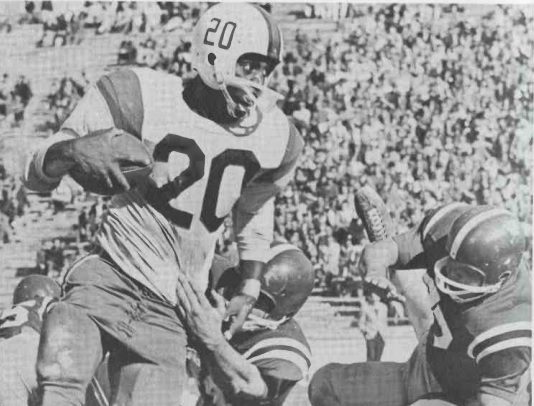
Arizona changed its coach — Jim LaRue replaced Doherty, who coached the Wildcats for only two years — and its helmet in 1959 with the numbers placed on the side of the white helmet with bold blue and red stripes on top. Pictured is Arizona Hall of Famer Warren Livingston (20). He excelled in track and field and football. After playing at running back, receiver and defensive back for the Wildcats, he went on to play with the Dallas Cowboys from 1961-66.
————
1960-69

Sixty years ago, in the 1960 season, Arizona went 7-3 under LaRue. Bobby Thomas (24) was one of the Wildcats’ famed “Touchdown Trio.” His 732 rushing yards led the team. The other standouts were quarterback Eddie Wilson with 1,020 passing yards and receiver Joe Hernandez with 442 receiving yards. The following year, in 1961, when Arizona finished 8-1-1, Thompson ran for 752 yards and had 468 yards receiving.
————
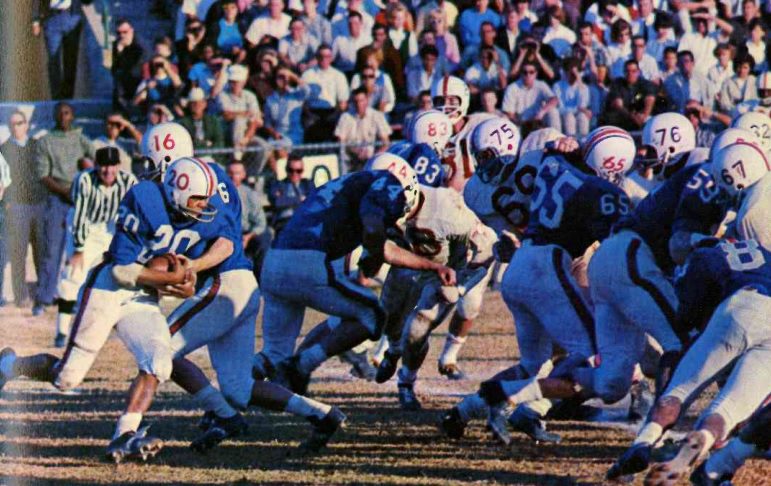
This is one of the first color photos of Arizona’s helmets and uniforms in 1963 when the Wildcats hosted New Mexico. The numbers on the side of the helmet are red. In this photo, halfback Rickie Harris takes the handoff from quarterback Bill Brechler.
————
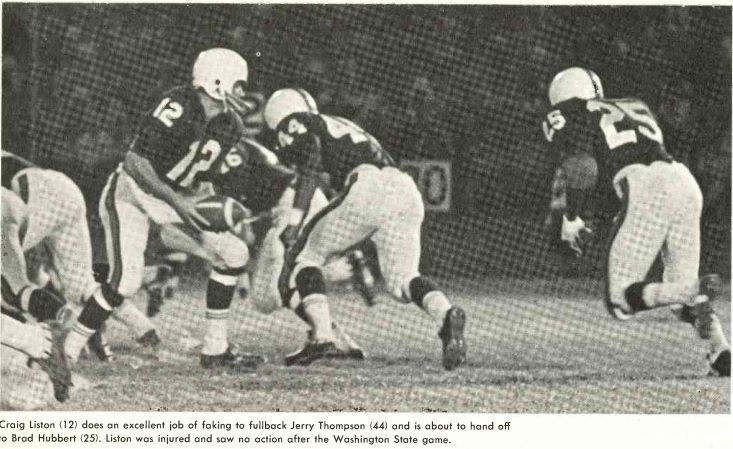
The Wildcats went without numerals on the side and tightened the blue and red stripes on top of the helmet in 1965. In this photo, quarterback Craig Liston (12) fakes the handoff to fullback Jerry Thompson and gives it to tailback Brad Hubbert (25).
————
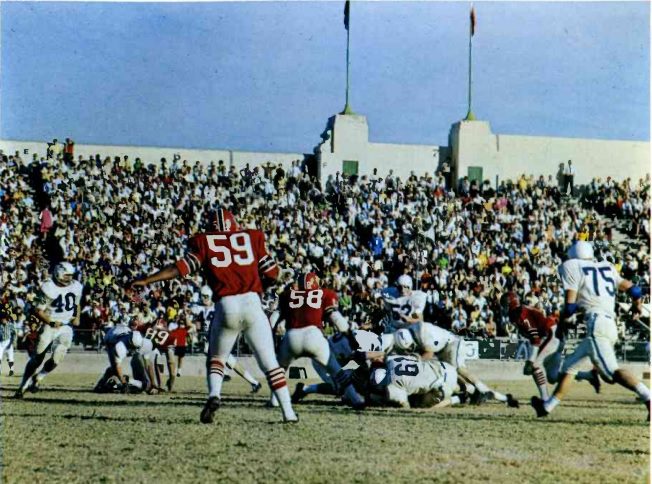

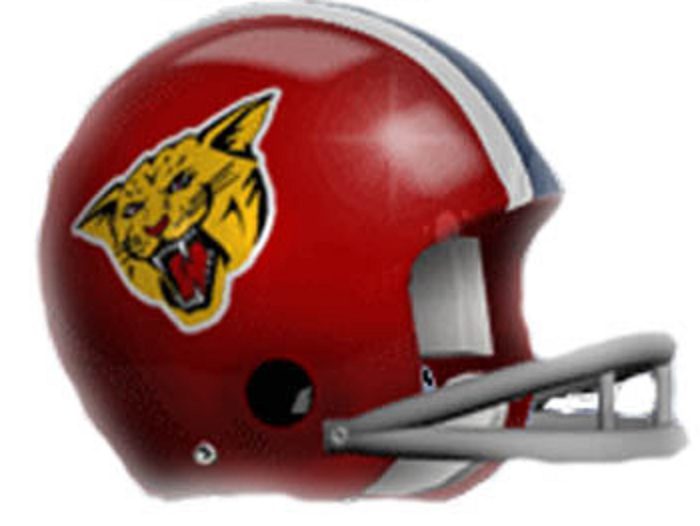
Darrel Mudra’s first season as head coach at Arizona in 1967 brought a significant change to Arizona’s helmet. The helmet went to red with a drawing of a wildcat on the side. Receiver Franklin Roberts (36) hauls in the pass in the above photo.
————

In 1968, Arizona went to only a red helmet with stripes of blue and white atop. In this photo, Mudra, in his second and last season with the Wildcats, talks with quarterback Bruce Lee. Arizona would maintain this look in Bob Weber’s first season as coach in 1969.
————
1970-79
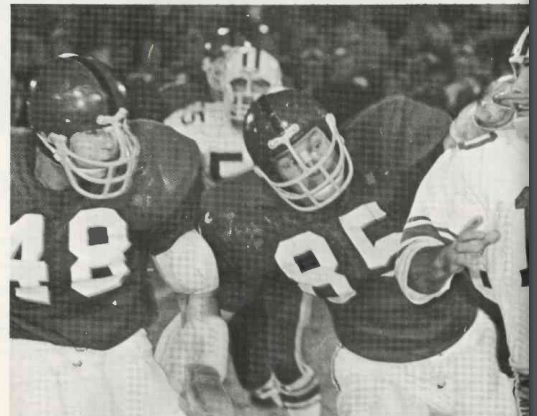
Fifty years ago, in the 1970 season, the Wildcats shifted their helmets a tade, keeping the red helmet with one dark blue stripe on top (no more adjacent white stripes). Bob Weber was in his second season and Arizona barely lost at Michigan 20-9 to start the year and also traveled to Iowa, winning 17-10. The Wildcats started 3-1 but went 1-5 the rest of the way, including a tough 10-6 loss at home against No. 9 ASU. Pictured are Arizona defenders John Eggold (48) and Bill McKinley (85).
————
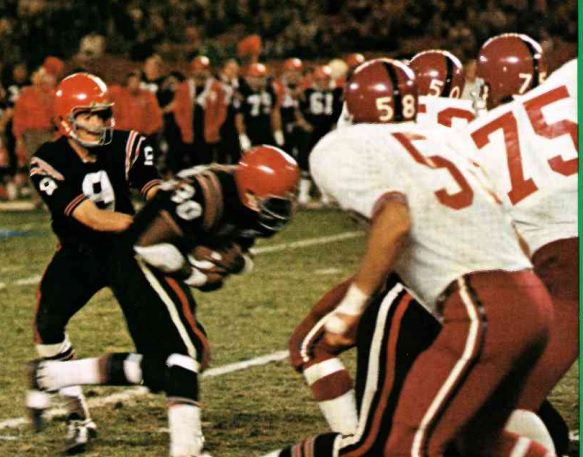
A color photo look of Arizona’s helmet look in 1971. Notice the white numbers on the back of the helmet.
————
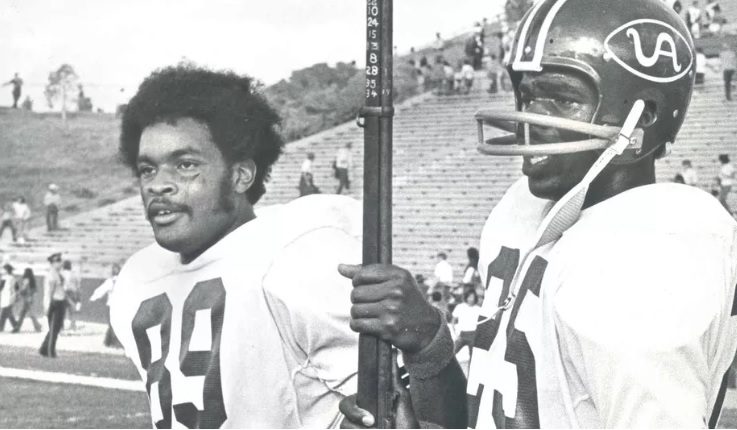
The last year of the brief Winslow era in 1972 brought with it a new helmet design with the snake UA in a football on a red helmet with white and blue stripes on top. Pictured above are the late Mark Neal (89) and Jackie Robinson (25) after the Wildcats beat New Mexico 27-15 to earn the Kit Carson Rifle.
————
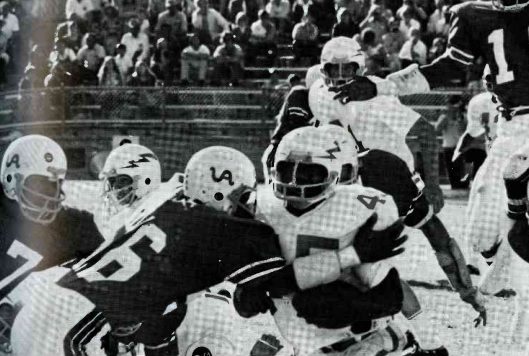
The start of the Jim Young era in 1973 included the return to white helmets with a particularly small snake UA logo on the side of the helmet.
————

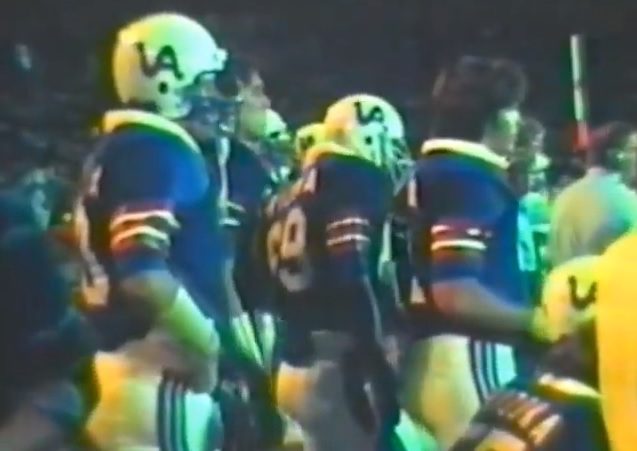
After displaying the too-small snake UA logo in 1973, Arizona enlarged it a bit in 1974.
————

The 1975 Arizona helmet included a wildcat caricature in the front, making it the second time a Wildcat symbol was placed on the helmet. The legendary “T” Bell is in the photo receiving another pass.
————
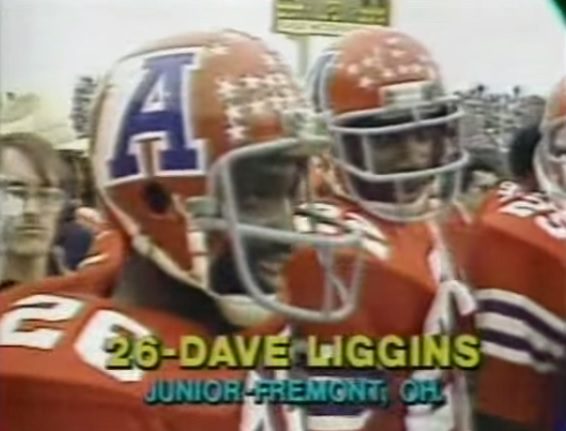

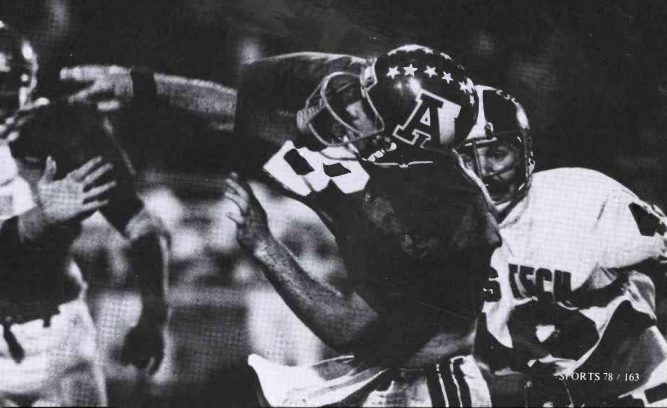
The Tony Mason era from 1977 to 1979 included the running A design on a red helmet. Arizona also left the WAC for the Pac-10 during this stretch. Top photo: Arizona safety Dave Liggins, who passed away in 2016, was named the Fiesta Bowl Defensive Player of the Game with his two interceptions of Pitt QB Dan Marino in the 1979 Fiesta Bowl. Middle: Brett Weber was an accurate barefoot kicker for Arizona. Bottom: QB Mark Lunsford unloads a pass against rival Texas Tech.
————
1980-89
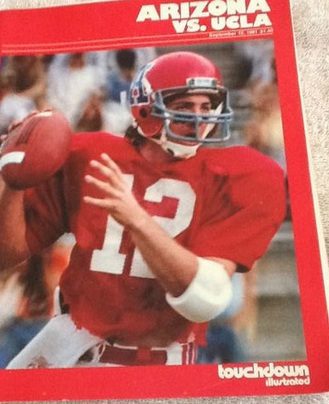
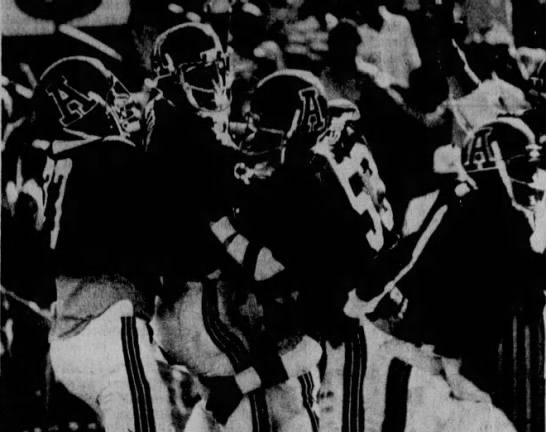
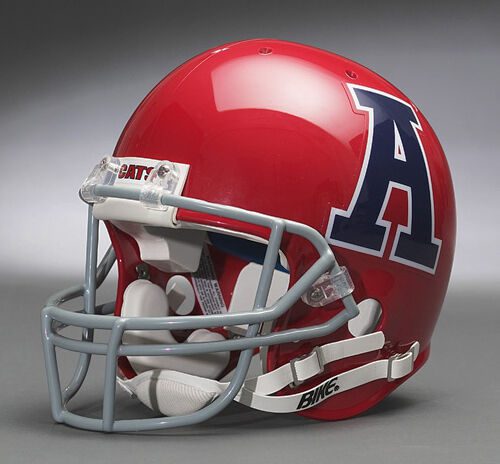
The start of the Larry Smith era in 1980 meant another new helmet design with the running A of the Mason years replaced with a long standing A on a red helmet. It would be the last time Arizona used a red helmet for 32 years. The 1980 team from 40 years ago played one of the most difficult and intriguing schedules in Arizona history with home games against No. 4 Notre Dame, No. 2 UCLA, No. 2 USC and ASU. Arizona went 1-3 in those games, with the win over the Bruins at Arizona Stadium. UCLA was on its way to be No. 1 with top-ranked Alabama losing earlier that day. The storied careers of quarterback Tom Tunnicliffe and linebacker Ricky Hunley began in 1980.
————
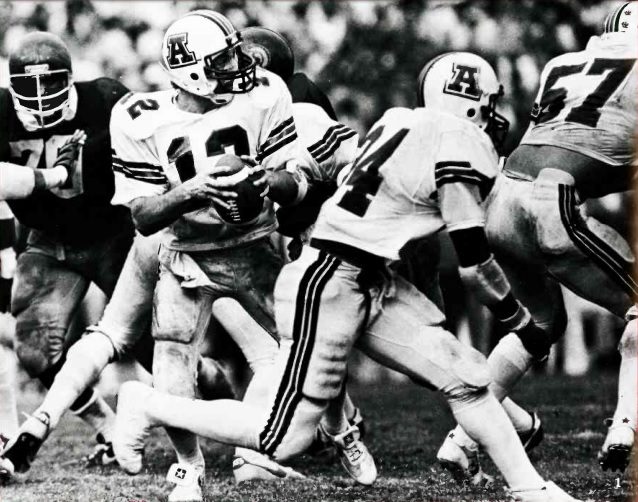
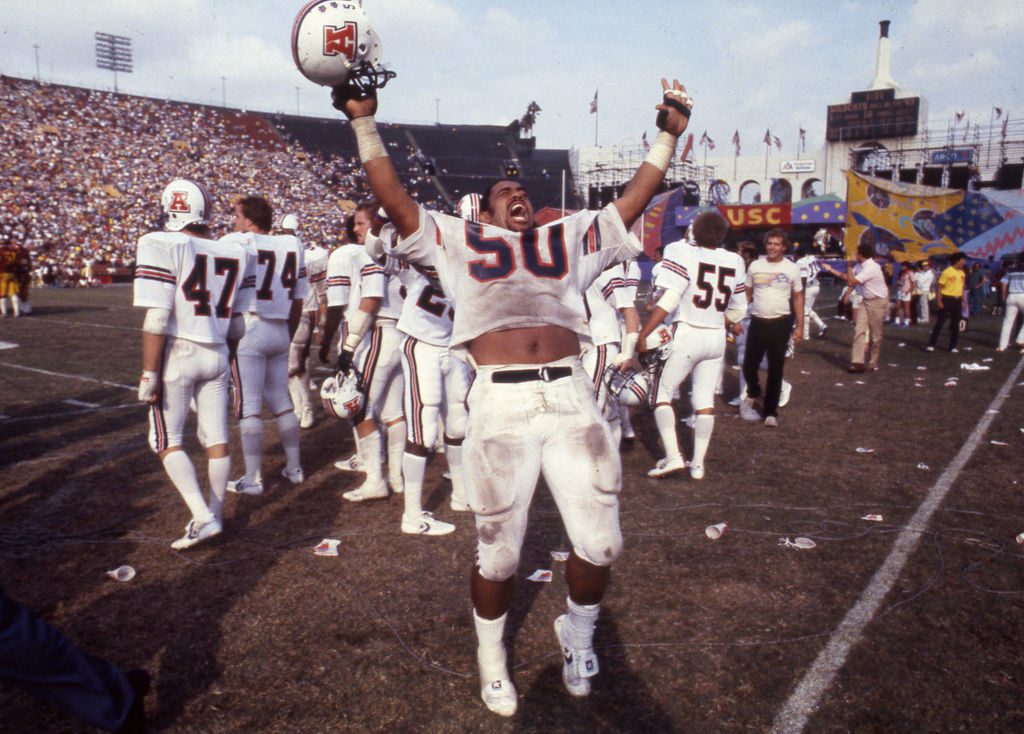

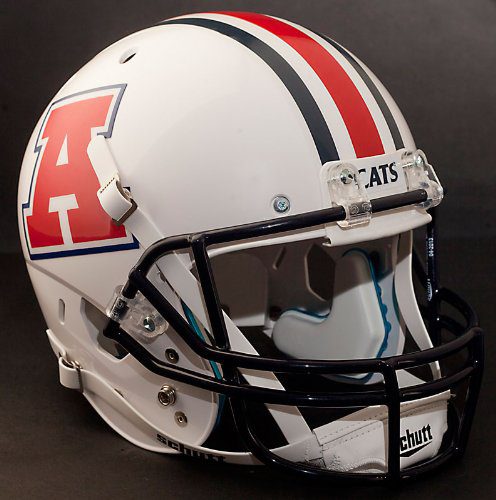
The Block A with three stripes (two blue surrounding one red) on top of the helmet made its debut in 1981. For the first time the facemask had color — navy blue. Two of the most historic upsets in Arizona history occurred with this helmet. The Wildcats beat No. 1 USC 13-10 in Los Angeles. Tunnicliffe (12) is shown going back to pass against the Trojans and Julius Holt (50) celebrates in what has become a legendary Tucson Citizen photo. Smith talks with his team in 1982 when Arizona beat No. 9 Notre Dame 16-13 at South Bend, Ind., on Max Zendejas’ last-second field goal.
————

A subtle change took place with the helmet the rest of the decade with the three-stripe design on top of the helmet changed to two stripes (blue and red). The decade of the Block A helmet includes “The Streak” against ASU, highlighted by Chuck Cecil’s 100-yard interception return for a TD against the Sun Devils in 1986 (photo above).
1990-99
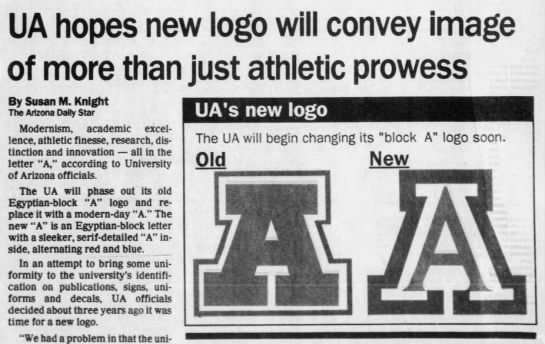
The Academic A design of Arizona’s logo on the team’s helmet is now 30 years old. The change from the Block A caused a little bit of controversy. Tucson Citizen columnist Corky Simpson chastised the cost to create the logo, referring to it as the “$30,000” A in one piece. “It was really a challenge to find something that represented the university for the academics and something that was also appropriate to athletics,” Arizona spokesperson Sharon Kha told The Arizona Star in February 1989 when the logo was first unveiled.
Arizona did not change its helmet design the whole decade of the 1990’s after converting to the Academic A with the white helmet for the 1990 season. That’s the first time that happened since the leather helmet days predating 1930. The decade was also the best in program history with a 10-2 record in 1993, with the famed Desert Swarm Defense, capped by a win over Miami in the Fiesta Bowl, and a 12-1 mark in 1998 finished with a victory over Nebraska in the Holiday Bowl. The Academic A would last into the next decade through 2003. The 1990 team 30 years ago finished 7-5 using the dual quarterback system of Ronald Veal and George Malauulu under Tomey. Arizona started 6-2 including a win at No. 15 USC, coached by former coach Larry Smith, but lost three of its last four games. The one win in that span was against ASU, which increased the unbeaten streak against the Sun Devils to nine years. The season ended with a 28-0 loss to Syracuse in the Aloha Bowl.
2000-09
The 2000 season 20 years ago marked the end of the 14-year tenure of Tomey as head coach. Arizona started 5-1 that season and was ranked No. 21 but then the Wildcats collapsed losing five consecutive games . Two of the first three losses in that stretch were at No. 7 Oregon and No. 8 Washington. They Wildcats lost those games by a combined seven points — 14-10 against Oregon and 35-32 against Washington. Those were sandwiched around a 27-24 loss to UCLA at home. A 33-9 loss at home to No. 10 Oregon State followed by a 31-17 defeat to ASU at Arizona Stadium put an end to things. John Mackovic replaced Dick Tomey and kept the white helmet Academic A look throughout his troubled tenure through 2003.
From 2004 through the end of the 2009 regular season, the start of the Mike Stoops featured all-blue helmets, the school’s first use of blue helmets since the 1950s. “We wanted to do something different to change our luck a little bit,” Stoops said of the switch to blue helmets. The Wildcats wore them in the 31-21 win over BYU in the 2008 Las Vegas Bowl, Arizona’s first appearance in a bowl since the 1998 Holiday Bowl win over Nebraska.
Arizona made its first in-season switch of a helmet in school history in 2009 when the Wildcats capped the season wearing all-white helmets in the 33-0 loss to Nebraska in the Holiday Bowl. Media critics of the all-white helmets to go with the white tops and white pants called it the “whitewashed” look. “After Nebraska’s blowout win, the question is will the Cats dare to don them again?” the Arizona Daily Star asked after the game. The answer is “yes.” The Wildcats still use the all-white helmet. They wore them at USC last season.
2010-19
The 2010 season 10 years ago marked one change with a white helmet used with a white facemask and a red and blue stripe on top. The Wildcats wore these helmets and the all-blue in a 7-6 season that started 7-1 with the lone loss in that stretch a 29-27 setback at home against Oregon State. Arizona was ranked as high as No. 9 in the nation. The Wildcats, with junior Nick Foles at quarterback, lost their last five games, including a frustrating 30-29 double-overtime loss at home against ASU and a 38-10 blowout loss to Oklahoma State in the Alamo Bowl. Throughout this decade, Arizona has used a variance of 14 different helmets with multiple looks each season.
In 2012, Rich Rodriguez’s first year as head coach, Arizona introduced a copper helmet — symbolizing the state’s historical copper mining industry — and also brought back the red helmet (with an all-red look) for the first time since Smith’s first year in 1980.
The 2014 season was a banner year with Arizona’s “Hill Mary” win over Cal with the “whiteout” helmet look (the only time the Wildcats have worn those) and the Pac-12 South title victory over ASU at Arizona Stadium (Arizona wore the all-red helmet for that game).
The red chrome helmet (which critics said resembled a Christmas ornament) was introduced when Arizona lost to UCLA in the 2015 season.
When Arizona hosted Hawaii to start the 2016 season, the Wildcats introduced the helmets honoring the USS Arizona on the 75th anniversary of the bombing of Pearl Harbor.
The matte-blue look with the red A was introduced in 2017, Rodriguez’s last season in Tucson. It was the ninth different helmet used in his six years as head coach from 2012 to 2017.
Three more helmet designs were introduced in Kevin Sumlin’s first season of 2018 — an all-white helmet with metallic masks of red and blue and the matte blue look with the traditional A instead of an all-red A.
Interesting that the two helmet looks started last season resemble what is featured in the championship match of the Arizona Football Helmet Bracket — the brushed red chrome look (a variance of the red chrome helmet that was introduced in 2015) and the retro look back to the Academic A days of the 1990s. The A is slightly shorter with a bolder font than the longer, thinner A of the helmet used mostly in the 1990’s but it was good to see Arizona try a throwback look.
.
FOLLOW @JAVIERJMORALES ON TWITTER!
ALLSPORTSTUCSON.com publisher, writer and editor Javier Morales is a former Arizona Press Club award winner. He is a former Arizona Daily Star beat reporter for the Arizona basketball team, including when the Wildcats won the 1996-97 NCAA title. He has also written articles for CollegeAD.com, Bleacher Report, Lindy’s Sports, TucsonCitizen.com, The Arizona Republic, Sporting News and Baseball America, among many other publications. He has also authored the book “The Highest Form of Living”, which is available at Amazon.













